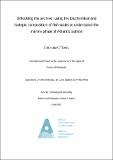| dc.description.abstract | The Atlantic salmon is a species of great importance culturally, economically and ecologically. Recent declines suffered by many populations have been linked to marine mortality, therefore a better understanding of the marine phase is needed to inform management decisions, slow population declines, and protect this iconic species. The overall aim of this research was to develop, validate and apply methods that unlock the information contained in Atlantic salmon scales to enhance our knowledge of the marine phase. Fish scales incorporate biochemical and isotopic signatures as they grow, acting as a chronological record of the fish’s life history. Large, multi-decadal archives of Atlantic salmon scales are held by many organisations, containing vast amounts of data to be explored. Stable isotopes of scales can be used to examine the diet, origin, and trophic level of prey of a fish, but inorganic carbonates on the scale surface can confound results. The carbon isotopic ratio (δ13C) of acid-treated and untreated scales from 208 Atlantic salmon was analysed. Acid-treatment had a negligible effect on (δ13C) and therefore does not need to be performed prior to stable isotope analysis (SIA) of Atlantic salmon scales, saving scale material, time and money. A recent isotope-based geolocation tool suggests that the marine feeding location of salmon can be determined by correlating a time series of scale δ13C with sea surface temperature (SST). To validate the method, SIA of archived scales from 100 fish (10 years of a 50-year period) caught at their feeding grounds west of Greenland was completed. The highest area of correlation between scale δ13C and SST, the Labrador Sea, accurately represented the foraging location of the fish. This validation allows the results of the geolocation tool to be interpreted with increased confidence. Cortisol, the most commonly measured stress hormone in fish, was recently extracted from fish scales as a measure of chronic stress. In this thesis, the method was adapted for use on Atlantic salmon scales and used to extract cortisol from the scales of 156 experimentally reared post-smolts that were exposed to 3 temperatures (6, 10.5 and 15°C) and varying starvation stressors. Cortisol increased significantly in fish kept at 15°C. Fluctuations occurred in fish at 6°C and in starved fish at 10.5°C, but a larger sample size is needed to determine the significance of these results. This research determined that scale cortisol is a suitable biomarker for temperature stress in Atlantic salmon and, due to optimisation to require lower weights of scale material, may open this method up to a wider range of species and life stages. Using the method, the stability of cortisol was confirmed in archived scales, then cortisol was extracted from 120 archived scale samples (6 years over a 29-year period). No interannual trends were detected, and individual variability appeared to drive the
differences in cortisol. Combining cortisol data with other analyses could help understand the factors affecting scale cortisol in Atlantic salmon. This research illustrated the value of scales for examining the marine phase of Atlantic salmon, which may be key to preventing further declines. The methods developed and validated in this thesis can be used to determine marine feeding location and to examine the response of salmon to stressors experienced during their life cycle. | en_US |


